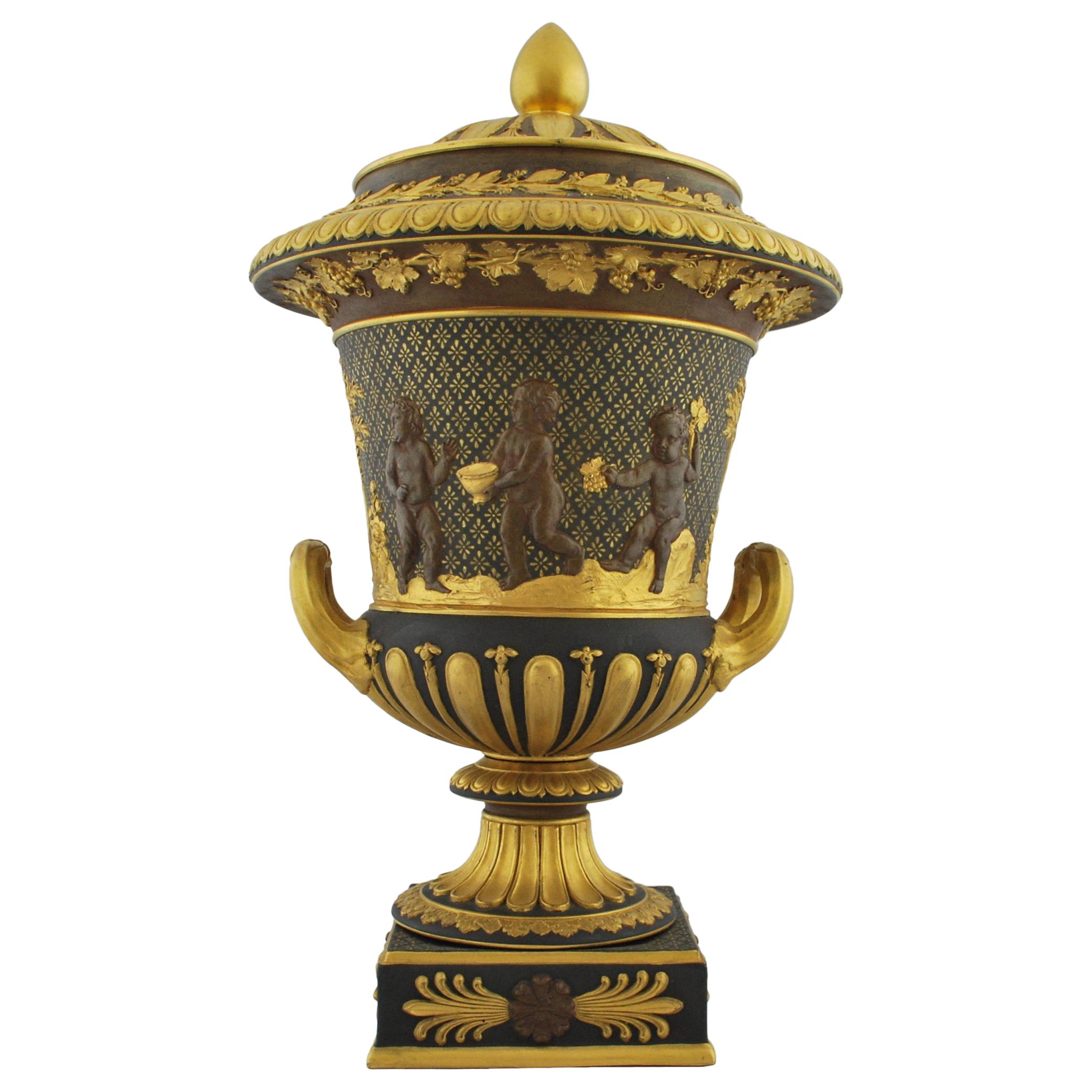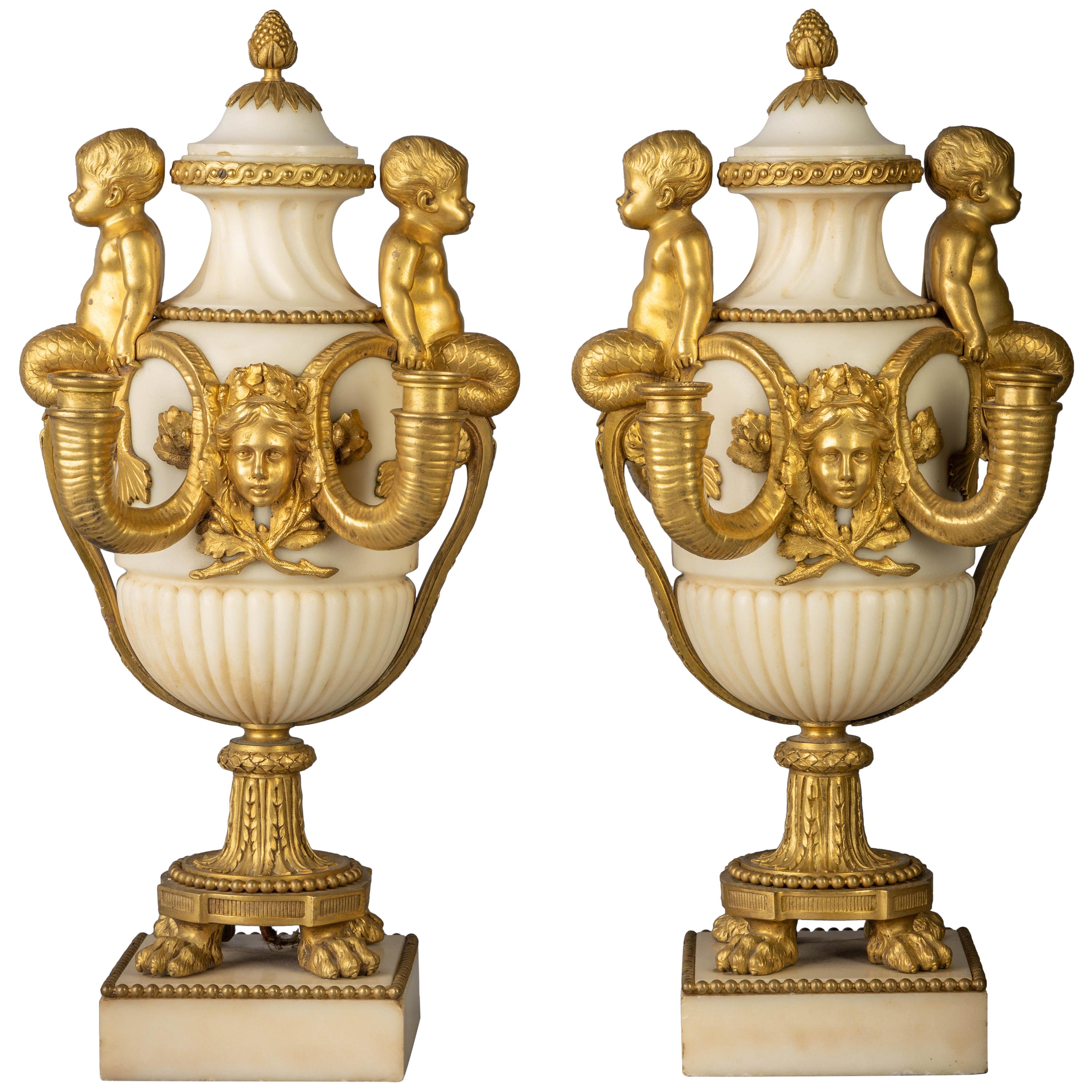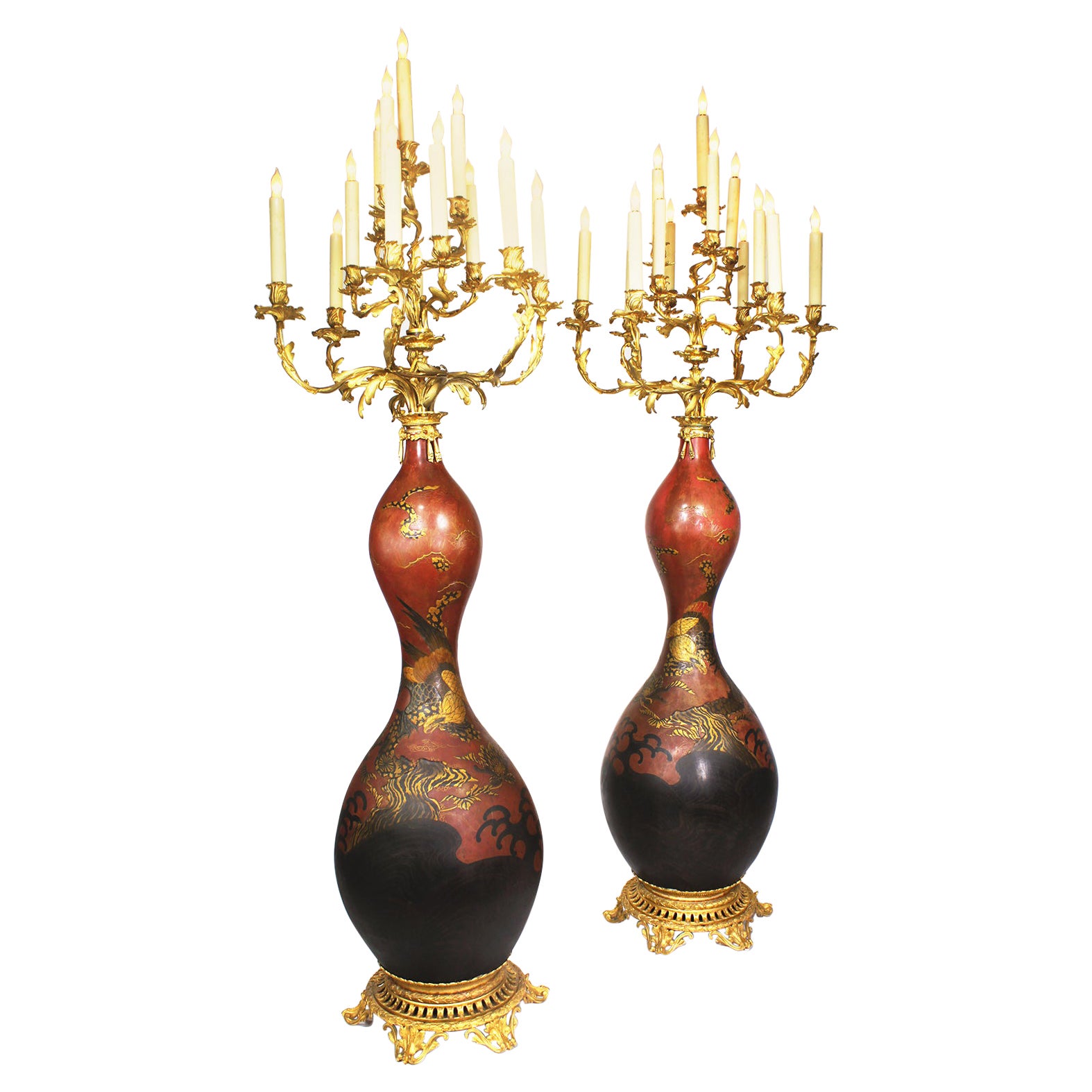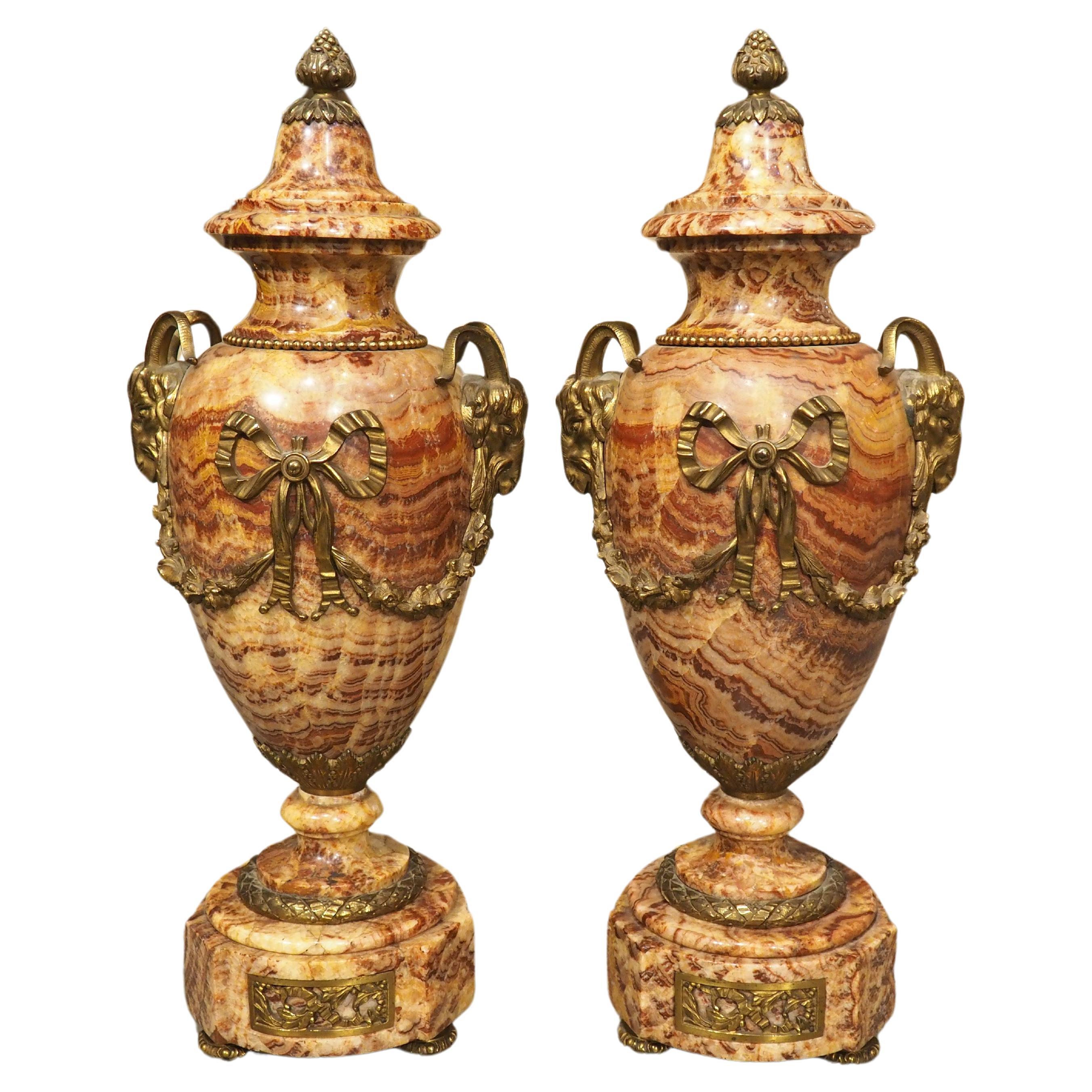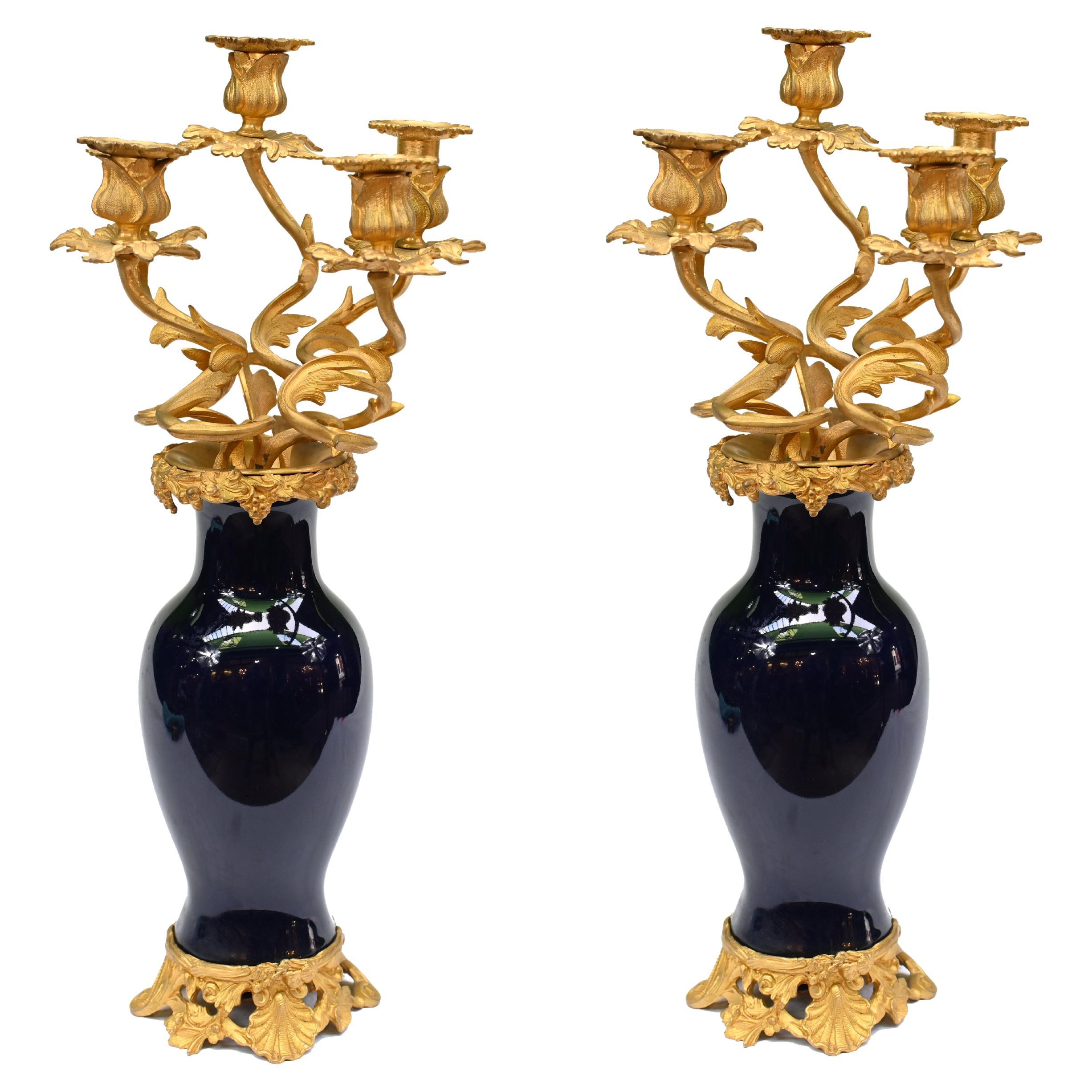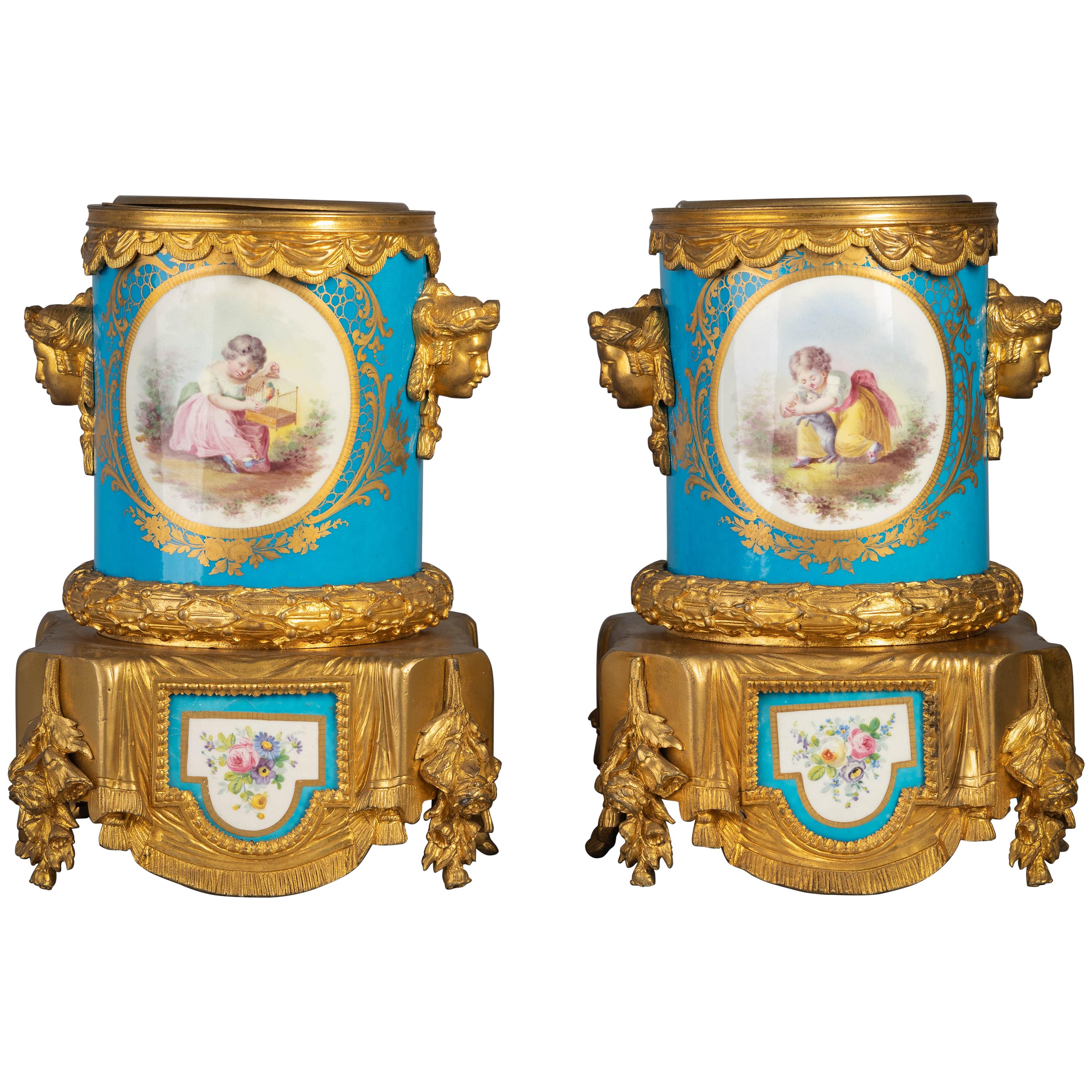Items Similar to Pair English Gilt and Bronze Candelabras Thomas Hope 1880
Want more images or videos?
Request additional images or videos from the seller
1 of 15
Pair English Gilt and Bronze Candelabras Thomas Hope 1880
About the Item
You are viewing a pair of antique gilt and bronze urns in the manner of Thomas Hope
The look is high Regency with a dazzling colour interplay between the black and gilt
They are classic amphora urns - Greek Revival - with various figures in relief
Each piece has six branches to the candelabras
Two feet tall - 60 CM - so good size on these
The casting to the gilt is very detailed and ornate with a great patina
We bought these from a private residence in London's Mayfair Offered in great shape ready for home use right away
We ship to every corner of the planet - please get in touch for a shipping quote
- Dimensions:Height: 24 in (60.96 cm)Width: 11 in (27.94 cm)Depth: 11 in (27.94 cm)
- Sold As:Set of 2
- Materials and Techniques:
- Period:
- Date of Manufacture:1880
- Condition:Wear consistent with age and use.
- Seller Location:Potters Bar, GB
- Reference Number:1stDibs: LU5875138986522
About the Seller
5.0
Gold Seller
These expertly vetted sellers are highly rated and consistently exceed customer expectations.
Established in 1966
1stDibs seller since 2021
89 sales on 1stDibs
Typical response time: 10 hours
- ShippingRetrieving quote...Ships From: Potters Bar, United Kingdom
- Return PolicyA return for this item may be initiated within 14 days of delivery.
More From This SellerView All
- Pair Antique French Candelabras Gilt and Porcelain Vase 1890Located in Potters Bar, GBEye catching pair of antique French ormolu candelabras mounted on cobalt porcelain vases Good size at almost two feet tall - 50 CM Ve...Category
Antique 1890s Vases
MaterialsBronze
- Pair French Gilt Cherub Candelabras Clodion 1880Located in Potters Bar, GBStunning pair of large gilt and marble candelabras in the Clodion manner Good size at just under three feet tall So eye catching with the pair of cherubs intertwined holiding aloft t...Category
Antique 1880s Candelabras
MaterialsBronze
- Pair Regency Porcelain Elephant Candelabras Gilt 1880Located in Potters Bar, GBStunning pair of porcelain elephant and gilt candelabras Such a great look to this eye catching pair which are a perfecct left and right The elephant spports the five branches of the...Category
Antique 1880s Candelabras
MaterialsBronze
- Pair Marble Cassolettes Stands Marble Vases Gilt Rams Heads 1880Located in Potters Bar, GBStunning pair of French marble cassolettes on gilt stands Such a great look to this highly decorative pair which are quite striking We date these to circa 1880 and the look is high E...Category
Antique 1880s Vases
MaterialsMarble
- Pair Bronze Urns Cherub Bacchus Italian Grand Tour Campana 1880Located in Potters Bar, GBAbsolutely stunning pair of bronze urns mounted on salmon pink marble pedestals The urns feature cherub scenes in relief around the urns as the partake in a Bacchanalian revelery whi...Category
Antique 1880s Urns
MaterialsMarble
- Pair Bronze Urns Cherub Bacchus Italian Grand Tour Campana 1880Located in Potters Bar, GBAbsolutely stunning pair of bronze urns mounted on salmon pink marble pedestals The urns feature cherub scenes in relief around the urns as the partake in a Bacchanalian revelery whi...Category
Antique 1880s Urns
MaterialsBronze
You May Also Like
- Campana Vase, Gilt and Bronzed, Wedgwood, 1880By WedgwoodLocated in Melbourne, VictoriaAn unusually large example of a scarce form of decoration. The vase is bronzed and gilded, in imitation of Japanese bronzes of the period.Category
Antique 1870s English Neoclassical Revival Garniture
MaterialsStoneware
- Pair of Gilt Bronze and Marble Figural Four-Light Candelabra, circa 1860Located in New York, NYThe covered urns with mer-child handles, the four arms interrupted with female masks, the gilt bronze base terminating in paw feet.Category
Antique 1860s French Urns
MaterialsMarble, Bronze
- Pair 19th Century Japanese Imari Porcelain & Gilt-Bronze Torchere CandelabraBy Imari PorcelainLocated in Los Angeles, CAA fine Pair of 19th century Japanese Imari Porcelain and French Gilt-Bronze Mounted Thirteen-Light Celadon Torchere Candelabra. The bottle-shaped Japonisme vases with a Royal red background, decorated with parcel-gilt and black soaring eagles in the hunt within a forestall scene. Each Vase fitted and surmounted with a French 19th century Louis XV Style 13-Light scrolled candelabrum and all raised on a circular pierced gilt-bronze plinth. circa: 1880. Imari Porcelain (????) is the name for Japanese porcelain wares made in the town of Arita, in the former Hizen Province, northwestern Kyushu. They were exported to Europe extensively from the port of Imari, Saga, between the second half of the 17th century and the first half of the 18th century. The Japanese as well as Europeans called them Imari. In Japanese, these porcelains are also known as Arita-yaki (???). Imari or Arita porcelain has been continously produced up through the present day. Characteristics Though there are many types of Imari, Westerners' conception of Imari in the popular sense is associated only with a type of Imari produced and exported in large quantity in mid-17th century. This type is called Kinrande. Kinrande Imari is colored porcelain with cobalt blue underglaze and red and gold overglaze. The color combination was not seen in China at that time. Traditional Ming dynasty color porcelain used dominantly red and green, probably due to scarcity of gold in China, whereas gold was abundant in Japan in those days. The subject matter of Imari is diverse, ranging from foliage and flowers to people, scenery and abstractions. Some Imari design structures such as kraak style were adopted from China, but most designs were uniquely Japanese owing to the rich Japanese tradition of paintings and costume design. The porcelain has a gritty texture on the bases, where it is not covered by glaze. There is also blue and white Imari. Kakiemon style Imari is another type of Imari, but it tends to be categorized separately in Europe. History "Imari" was simply the trans-shipment port for Arita wares. It was the kilns at Arita which formed the heart of the Japanese porcelain industry. Arita's kilns were set up in the 17th century, when kaolin was discovered in 1616 by the immigrant Korean potter, Yi Sam-pyeong (1579–1655). (He may also be known by the name, "Kanage Sambei".) Yi Sam-Pyeong, along with his extended family of 180 persons, left Korea on the offer of a privileged position in Japan. This decision was made after the occurrence of certain Japanese invasions of Korea. After Yi Sam-Pyeong's discovery, his kilns began to produce revised Korean-style blue and white porcelains, known as "Shoki-Imari". In the mid-17th century there were also a lot of Chinese refugees in Northern Kyushu due to the turmoil on Chinese continent, and it is said one of them brought coloring technique to Arita. Thus Shoki-Imari developed into Ko-KutaniImari. Ko-Kutani was produced around 1650 for both export and domestic market. Blue and white porcelain continued to be produced and they are called Ai-Kutani. Ko-Kutani Imari for the export market usually adopted Chinese design structure such as kraak style, whereas Ai-Kutani for the domestic market were highly unique in design and are accordingly valued very much among collectors. Ko-Kutani style evolved into Kakiemon style Imari, which was produced for about 50 years around 1700. Imari achieved its technical and aesthetic peak in Kakiemon style, and it dominated European market. Blue and white Kakiemon is called Ai-Kakiemon. Kakiemon style transformed into Kinrande in the 18th century. Kinrande used blue underglaze and red and gold overglaze, and later some other colors. Imari began to be exported to Europe because the Chinese kilns at Ching-te-Chen were damaged in the political chaos and the new Qing dynasty government stopped trade in 1656–1684. Exports to Europe were made through the Dutch East India Company, but the designation "Imari Porcelain" in Europe connotes Arita wares of mostly Kinrande Imari. Export of Imari to Europe stopped in mid-18th century when China began export to Europe again, since Imari was not able to compete against China due to high labor cost. By that time, however, both Imari and Kakiemon style were already so popular among Europeans, Chinese export porcelain copied both Imari and Kakiemon style, which is called Chinese Imari. At the same time, European kilns, such as Meisen also tried to copy Imari and Kakiemon. Export of Imari surged again in late 19th century (Meiji era) when Japonism flourished in Europe. Thus in western world today, two kinds of Imari can...Category
Antique 19th Century Japanese Japonisme Floor Lamps
MaterialsOrmolu, Bronze
- Pair of C. 1880 French Louis XVI Style Carved Marble and Gilt Bronze CassolettesLocated in Dallas, TXAlthough the origin of cassolettes can be traced back to ancient Europe and Asia, it was not until the late 18th century that cassolettes began to develop the urn-like form seen on t...Category
Antique Late 19th Century French Louis XVI Urns
MaterialsStone, Marble, Metal, Bronze
- Pair of Gilt Bronze Mounted 'Sevres' Porcelain Wine Coolers, circa 1880Located in New York, NYPair of gilt bronze mounted 'Sevres' porcelain wine coolers, circa 1880.Category
Antique 1880s French Wine Coolers
MaterialsPorcelain
- French Art Nouveau Gilt Bronze Vase, circa 1880Located in New York, NYWith berries and foliage in high relief. Signed D. Simon.Category
Antique 1880s French Vases
MaterialsBronze
